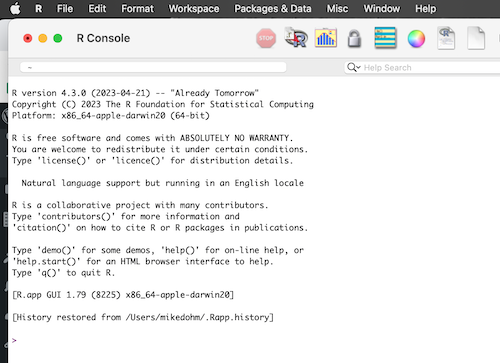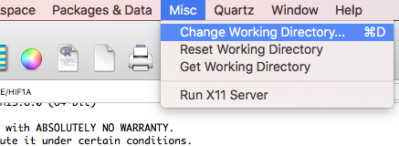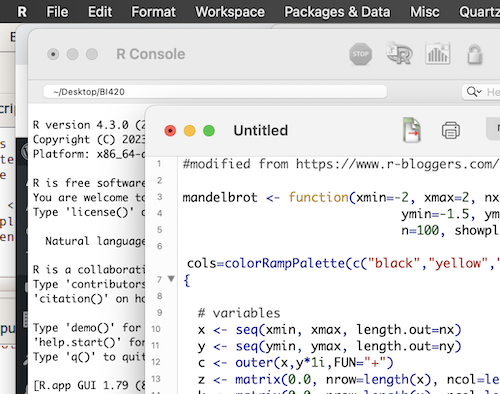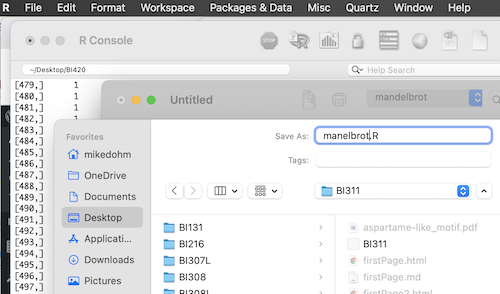Part 02. Getting started with R and Rcmdr
What’s on this page?
A lot! Scan a topic, pick and choose. The goal was to provide lots of “how tos” and you would return as “how do I…” questions arise.
- Project management — Prepare your computer
- Start R
- Start R Commander
- Stop, exit, quit current R session
- Identify Working folder in R
- Change Working folder in R
- Access and use R GUI script window
- R Commander windows
- Call system commands (optional)
- References and suggested readings
- Quiz
Chaminade BI311 students using R Commander should skip 7 and go to 8 on R Commander windows. BI420 students can skip items 3 and 8.
What to do
The objective is to decide which coding environment you will use for the semester. Your options include
- R Commander with the Rcmdr script window
- R GUI app, code entered and run from a script document
- RStudio
- R GUI app, commands entered at the command line and R prompt
How to do it
My recommendation for BI311 students, option 1 is the way to go (see justification Why R Commander in Mike’s Biostatistics Book). We are starting from the perspective that your experience with R to date is minimal. RStudio is the choice for coding and managing statistical projects; however, it’s way more IDE for beginners with statistics. Although R Commander will work within R Studio, the experience is not great. Thus, R and R Commander or R and RStudio, but not R plus RStudio plus R Commander.
This page is about working with R and R Commander together. Learn how to start and stop R and R Commander. Setup your environment, which is the foundation for project organization. Introduce the idea of writing code as script. There’s also some code to explore how to call system commands from within R. Operating specific code is provided. Wikipedia links to common computer terms are provided.
1. Project management — Prepare your computer
To do before starting R
- We want you to get into the habit of setting working folders.
- So if you have not already done so, set up a working folder (e.g., BI311) and make it available in R.
- Practice using
getwd()andsetwd().
- Use
Sys.getenv()to locate where on your computer R is installed. - Optional, explore use of system commands within R to move around on your computer.
What is a working folder?
During the semester you’ll be working on a number of projects. Some projects will have a few files, others may have dozens of files. It’s therefore good practice — a basic data management skill — to apply project organization: Set up and use a folder/file structure for your work in the course.
The steps described here show you how to change your working folder for an R session. Once you end the session (e.g., exit R), then the next time you start R, you’d have to repeat these steps to change your working folder. I prefer this approach because I work with many different R projects, so I have working folders for each project, and use scripts which include steps to change to the preferred working folder. However, you may prefer to make the working folder the default choice. You can do this by editing a text file called .RProfile. How to edit this file is described in the Optional: Modify .RProfile page.
Setup a working folder on your computer
Create a folder on your computer to hold all of your R work. For example, it might be something like “BI311” as a subfolder on your Desktop or in your Documents folder. Note that USERNAME would be specific to your computer; replace BI311 with the name of your working folder.
Point your working folder locally, not to the cloud. New versions of macOS and Windows (Win11) both steer users to save files to cloud drives, iCloud and OneDrive, respectively. This occurs during operating system setup as a choice where to locate the home folder. This is fine, provided internet access is available, or more importantly, if more than one computer device is used. However, beginners will generally find a better user experience working with R if working folders are set to local drive, not cloud drives. Part of the explanation for this is that apps make assumptions about file locations.
On a Mac, the path to BI311 off the Desktop would be
/Users/USERNAME/Desktop/BI311
You can copy the path as displayed to R in the next step (Identify Working Folder in R).
- macOS tip: Want to quickly view the Desktop? Keyboard shortcut
Cmd+F3orFn+F11will work. - macOS tip: To view the path, Finder → View → Show Path Bar (keyboard shortcut
Alt+Cmd+P).
MacOS readers, you’re good to go. Skip down to Start R.
Win11 readers, we have a little work to do, so begin. On a Win11, the path to BI311 off the Desktop would be
C:\Users\USERNAME\Desktop\BI311
You can copy the path as displayed to R in the next step (Identify Working Folder in R).
- Win11 tip: Want to quickly view the Desktop? Keyboard shortcut Windows key ⊞ +D
- Win11 tip: To view the path, File Explorer → View → Options → Change folder and search options → View → Display the full path in the title bar (check the box)
Win11 uses “\” (backward slash), not “/” (forward slash) like macOS — and everyone else in the computer world! A long time ago, Microsoft chose to go against the forward-slash convention, and we’ve been paying for it ever since. We provide a few options (tricks) to get R to help here — see Trick 1 and Trick 2 below.
Microsoft had good reason for their choice, and when the choice was made, standards were very much in debate. Wikipedia has a pretty good discussion on the backslash and I leave the question to interested readers to pursue on their own.
To R, a backslash is treated as an escape character. Unfortunately, you’ll need to change this. So, either retype the path to replace backslashes with forward slashes
C:/Users/USERNAME/Desktop/BI311
Or, you can use one of the following tricks. Copy the Win11 path to the clipboard, then
Trick 1: write and submit the command in R
setwd(readClipboard())
the readClipboard() function takes the forward slashes and replaces with “//”. Check the directory was changed
getwd()
returns
"C:/Users/USERNAME/Desktop/BI311"
this will work for us without further modification. With the extra backslash our path backslash is not treated as an escape character.
Trick 2: treat the path as a raw string (Hadley et al 2020).
setwd(r"(C:\Users\USERNAME\Desktop\BI311)")
r"" allows you to write the path as a “raw string constant.” h/t Henrik response at stackoverflow.com.
Continue reading — we return to paths when we introduce setting the working folder in R.
2. Start R
Mac users, the app is simply R.app. Win11 users, the app is Rgui.exe. Start as you would any application installed on your computer.
Figure displays R session immediately after start, running on macOS.

3. Start R Commander
It is not necessary to run R in RStudio or, for that matter, R Commander. The basic R GUI includes the facility to start, open, and save script files, which is the lifeblood of R coding. However, as of Fall 2023 I continue to recommend that new statistics students run R within R Commander because it provides access to function calls from drop down menus. Off we go.
At the R prompt (the “>” in Figure 1), type
library(Rcmdr)
R is case sensitive. That means, type exactly library(Rcmdr), not Library(Rcmdr) or library(RCMDR), etc.
4. Stop, exit, quit current R session
Quit, prompt with prompt to save workspace image. For most users just getting started, select Don’t save.
Let’s get to work
You may complete the next work within the standard R work area, or from an R script, or within the R Commander script window. Commands intended to move about your computer obviously won’t work if you’re running R in the cloud (CoCalc or Colaboratory), but other commands will work fine!
From here on I assume you are working in R Commander’s script window. Don’t forget to submit you commands in R Commander (place the cursor at start of the code, then press Submit button).
5. Identify Working folder in R
Now that R Commander is running, let’s get our environment set up.
First, what is the current Working directory (folder)? This is the default location where R will save files (it was established based on choices you made when you first installed R).
Type the function
getwd()
then submit. R will show something like (macOS result)
[1] "/Users/USERNAME/"
Second, change default folder in R to match the working directory you just created. You’ll need to copy the full path to your clipboard. Skip down to Change Working Folder in R.
macOS users — if copy/paste fails with R, see Can’t copy/paste into R script, macOS to solve the problem.
Yet another option, check location your R installation (R_HOME) and your current working folder (HOME).
Sys.getenv(c("R_HOME","HOME"))
On my Win11, R returns
>Sys.getenv(c("R_HOME","HOME"))
R_HOME HOME
"C:/R/R-4.1.0" "C:\\Users\\USERNAME"
On my macOS Catalina, R returns
>Sys.getenv(c("R_HOME","HOME"))
R_HOME
"/Library/Frameworks/R.framework/Resources"
HOME
"/Users/USERNAME"
Note: my computer usernames obviously are not USERNAME, just choose not to share.
If you recall our work with forward slash and Win11 paths above, we have an object called myFolder. We can now set the working folder simply by writing and submitting the following code at the prompt
setwd(myFolder)
Alternatively, if you’re running Win11 (this doesn’t work on macOS), I can get help from R with this task. At the R prompt write and submit
choose.dir()
which will bring up Explorer (Windows). You then browse to the folder you created on your desktop. from which you can select the directory (folder) you wish to use (see On Win11 PCs, you can combine setwd() and choose.dir() below).
A related function is file.choose(), but for selecting files, not folders. This function does what it says, it allows you to find and load files into R and it works on both macOS and Win11 PCs. On macs you can use this function much like the choose.dir() command. If you have a file already in the folder, then skip this next suggestion, just use file.choose() to browse to your folder and select a file. If the working folder is empty, then create and save a text file to the folder. For example, I created a text file in TextEditor called justAfile.txt and saved to my working directory. Then, in R
myFolder <- file.choose()
The object myFolder holds the path to justAfile.txt
[1] "Users/USERNAME/Desktop/BI311/justAfile.txt"
Now, just edit the object, remove “justAfile.txt” There’s a variety of ways to do this — the simplest is to just copy/paste into TextEdit and then use the result. Or, you can use the following
myPath <- unlist(strsplit(myFolder, split="justAfile.txt", fixed = TRUE))
Confirm R has done the work, write and submit myPath. R should reply with
[1] "Users/USERNAME/Desktop/BI311/"
6. Change Working Folder in R
Change the Working directory to a folder you created above in Setup a working folder on your computer. There are several ways to do this. One option is to use the menu in the console. For example on a macOS: Misc → Change Working Directory… (Figure 1).

Figure 1. Screenshot of the macOS R.app console, selecting the Change Working Directory… option.
On Win11: File → Change dir…
Browse and select the folder in the same way you would for any app on your computer.
A second option is simply to tell R where to look using the setwd() function. Type the path or drag the folder/path into R
Example for macOS users:
#replace USERNAME with your user name. Replace BI311 with the name of your working folder
setwd("Users/USERNAME/Desktop/BI311/")
Example for Win11 users:
#replace USERNAME with your user name. Replace BI311 with the name of your working folder
setwd("C:/Users/USERNAME/Desktop")
Or, if you have not changed the backslash used in Win11 path to forward slash, the example was
setwd("C:\\Users\\USERNAME\\Desktop\\BI311")
On Win11 PCs, you can combine setwd() and choose.dir()
An advanced option is to nest the choose.dir() function within the call to set the working directory, like so
setwd(choose.dir())
which brings up a pop-up Explorer (Windows) from which you can select the directory (folder) you wish to use.
Again, this doesn’t work for macOS.
7. Access and use R GUI script window
Assuming you have pointed R to your working folder, create a new script document file. The following instructions show R GUI in a MacBook, but the instructions and view are similar in Windows PC.
From the R.app menu, select File > New Document
The editor pops up with a text file.
Enter your script into the text area. When ready to run the script place the cursor at the line you wish to submit or highlight regions of code you wish to run. Then, press Command + return keys (Macs) or Ctrl + R key (Windows PC) to run the code.
Don’t forget to save your work. File > Save as…
8. R Commander windows
R Commander provides access to many statistical commands via drop down menus. It is organized into four parts:
- Menus
- Script window
- RMarkdown window (the second tab): See Part 09: Making a report
- Output window
- Messages window

Use menus to select Data to import and manage datasets, Statistics to Summarize (descriptive statistics), make inferences, or model data, Graphs provide access to several graph types, plus additional R commands.
The Script window can be used to enter commands directly (highlight one or more lines of code, press Submit button to run the code). R Commander will also print out the function calls made via Menus; this is a good way to learn how to code — R Commander generates the code based on menu choices, you then can go back and make changes to the code, adding color options, font size, etc., to refine your work.
We will rely on the script window in R Commander to carry out our work this semester. For more about the script window, see the Appendix: How to enter and run R code
Results from R commands are printed to the Output window. Graphs will popup as new windows. You may have to move around to find graph windows that may get hidden because we have several windows open on our desktops.
Error messages show up in red in Messages window. Error generates error reports when we have mistakes in our commands. Messages can start piling up; we can reset or clear the messages by clicking in the Message window, then selecting Rcmdr: Edit → Clear window.
9. Call system commands (optional)
Lastly, you can run simple commands on your computer, like checking files in a folder, while running R. Both macOS and Win11 has several 100 commands that can be entered through the terminal.
Note: This section should be viewed as optional — more of a proof of concept as opposed to something beginning students should attempt.
For example, on Win11, type and submit the following command in R
shell("dir /o")
and you’ll get a list of the files currently in your working folder.
On macOS, type and submit the following command in R
system("ls")
and you, too, will get a list of the files currently in your working folder.
Here’s another useful system command call from within R. Let’s say you want to check if our web site is running. One option is to ping the url letgen.org. Here’s how to do this in R running on Win11.
system2("ping",c("letgen.org"," -n 1"))
And R returns
Pinging letgen.org [50.87.81.216] with 32 bytes of data: Reply from 50.87.81.216: bytes=32 time=86ms TTL=53 Ping statistics for 50.87.81.216: Packets: Sent = 1, Received = 1, Lost = 0 (0% loss), Approximate round trip times in milli-seconds: Minimum = 86ms, Maximum = 86ms, Average = 86ms
On macOS
system2("ping",c("letgen.org"," -c 4"))
And R returns
PING letgen.org (50.87.81.216): 56 data bytes 64 bytes from from 50.87.81.216: icmp_seq=0 ttl=53 time=85.519 ms 64 bytes from from 50.87.81.216: icmp_seq=1 ttl=53 time=85.528 ms 64 bytes from from 50.87.81.216: icmp_seq=2 ttl=53 time=86.364 ms 64 bytes from from 50.87.81.216: icmp_seq=3 ttl=53 time=86.485 ms --- letgen.org ping statistics --- 2 packets transmitted, 2 packets received, 0.0% packet loss round-trip min/avg/max/stddev = 85.519/85.974/86.485/0.453 ms
Note the subtle difference between macOS and Win11 “ping.” Win11 we use the -n option to set the number of echo requests to send (in this example we requested just 1 echo), whereas for macOS the -c option does the trick (and we set 4 echo requests). (macOS uses the correct UNIX commands, Win11 is doing it’s own thing.)
Warning!
This next system command call can take a while on your computer — the command (systeminfo, system_profiler) is requesting a lot of information so the reply from your computer may take several seconds to complete.
And finally, you may need to get information about your computer. Rather than clicking through Win11 to get information, you can run an R command and save it to an R object like so.
myCPU <- system2("systeminfo", stdout=TRUE,stderr=TRUE,wait=TRUE); myCPU
and a long list about my Win11 computer will be stored in the object myCPU and displayed to the screen because I tagged on “;myCPU” at the end of the command. (Results not shown, it’s long).
On the macOS, one could repeat the above command, replacing “systeminfo” with “system_profiler“. However, I don’t recommend use of system_profiler (read further below) — instead for the macOS try sysctl .
I mentioned a warning. How long does systeminfo or system_profiler take? It’s going to depend on your computer, but if you’re curious, you can get the answer by wrapping the commands within an R function called system.time().
Here’s what the code would look like.
Win11
system.time(system2("systeminfo", stdout=TRUE,stderr=TRUE,wait=TRUE))
On my Win11 machine, the results were
user system elapsed 0.00 0.00 2.12
the elapsed time is the answer, 2.12 seconds.
On macOS
system.time(system2("system_profiler", stdout=TRUE,stderr=TRUE,wait=TRUE))
And on my macOS laptop, well, the spinning pinwheel flashed, then R crashed the second time I tried to run the system_profiler command. system_profiler is very, very thorough, returning much more information about your machine and software than you want to know. In fairness to R, I was running several other apps at the same time (word processing and spreadsheet, networking software to share my screen, PowerPoint, Quicktime Player and several other apps). Just a reminder, best to shut down unnecessary apps. I shut down all other apps, restarted R and gave it another shot. Results were
user system elapsed 42.744 16.860 66.468
In conclusion, you CAN check system information, and on Win11 it is reasonable to do so within R. On macOS? Not recommended!
Note. You may be wondering about the three times: user, system, elapsed. A quick answer: elapsed time is the one that corresponds to your real world wait time for your computer to be available to you again; user time refers to how long it took for the code to be executed; system time includes time to complete the code but also to running necessary system functions. For a better answer you’re going to have to get into the weeds and learn about kernels and … 😉
10. References & Suggested readings
11. Page quiz
Getting started
Seven questions from this page



